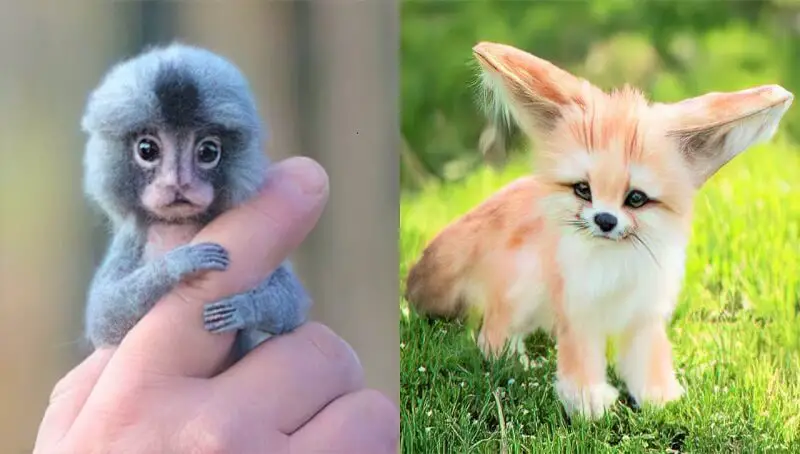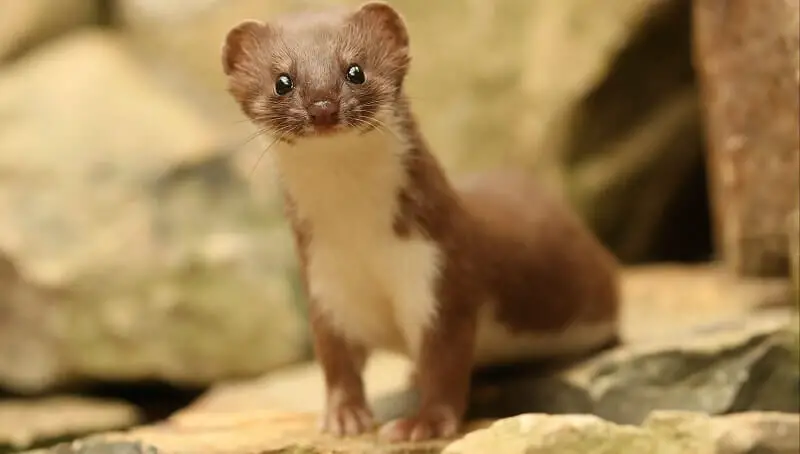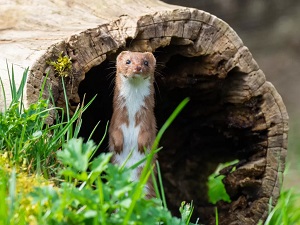
Exotic Pets Explained
October 28, 2022
Why is Your Cat Peeing on Your Bed?
October 30, 2022
- Area: Northern Hemisphere
- Habitat: Forests and open areas
- Food: Carnivore (mice, lemmings)
- Size: 22 – 38 cm
- Weight: 240 – 400 g
- Speed: 25 km/h (15 mph)
- Colors: Dark and light brown, black, and white
- Reproduction: 5 offspring
- Predators: Fox, snake, elk
- Live: Solitary
- Average age: 1 to 3 years in the wild
- Features: The smallest carnivorous animal
In America, the weasel, Mustela nivalis, is a domestic animal by definition. There are no wild weasels except in North America, where they have been left in the wild by man, not being dangerous and having basically no hunting instincts.
Lately, it is so popular that it is adopted as a pet, and I guarantee you that if it is given love and attention, it attaches easily to any owner.
What does the weasel eat?
The weasel needs protein-rich food, as it is mainly carnivorous. You can also use dry cat food but pay attention to the protein concentration, to be over 32%, and the amount of magnesium to be low; they do not need much magnesium in their diet.
They are big lovers of unsalted peanuts, popcorn, bananas, and peanut butter. But these foods should not be their daily meal. They must be offered just as treats, so do not give them in large quantities. Under no circumstances should you give them chocolate or caffeine products. They may beg but not be impressed; although we are not affected by our chocolate consumption, the weasel may suffer from it.
You might also like my articles with interesting facts about capybaras, lemmings, or stoats.
In the wild, the weasel hunts rabbits, mice, birds, frogs, squirrels, and other small animals. It can often be found standing in guard at the holes of the burrows of the animals it hunts.
It usually hunts at night. The weasel stops its prey by biting it on the back of the head. Poultry breeders do not like weasels because they can eat a few birds in a single attack, but, at the same time, they are also useful animals because they feed on mice and other rodents harmful to humans.
How can you recognize a weasel?
The weasel has a thin, elongated, and very flexible body. The eyes are large, bulging, and dark. The legs and tail are relatively short, which are less than half the length of the body.
Legs end with sharp claws. Each individual usually has 4 pairs of nipples, but only those from females are visible.
The length and size of the species vary depending on the region. Males can be 1.5 times larger than females. The tail also varies from 13 to 30% of the length of the animal’s body. The average length in males is 13 – 26cm and in females 11 – 20cm.
The fur is dense, short, and soft. The upper parts are darker in color and vary geographically from dark red to sand color.
The lower parts, lower jaw, lower legs, and belly are white.
Weasel behavior
 The weasel is a fierce and fast animal despite its small size.
The weasel is a fierce and fast animal despite its small size.
It is an agile hunter moving close to the prey without being heard and then it throws itself at the victim and grabs it.
Some people think the weasel smells worse than a skunk because of its glands.
It is hunted by snakes, hawks, and owls. It’s also hunted by humans for its gorgeous fur.
It is known for its aggression by many animals. Some believe that the female weasel hurts other animals for no reason even when it is not hungry.
They’re just as curious as raccoons. The weasels check every hollow, every bush, they are looking even behind every tree.
Weasel reproduction
The mating period of the weasels is from April to July. The gestation period lasts 34-37 days. In the Northern Hemisphere, the average litter is of 6 offspring per season, that reach maturity in 3-4 months.
Males can mate in the first year of life, which is usually not successful.
The babies are pink at birth, they are naked, blind, and deaf. At only 4 days they begin to grow soft and fluffy fur that protects them.
At 10 days, you begin to see the difference between the colors of the fur, the upper and the lower white. After 2-3 weeks, baby teeth appear, but breastfeeding can last up to 12 weeks.
The eyes and ears are fully functional at around 4 weeks of age, and by 8 weeks the hunting instinct is developed.
After 12 weeks, everyone starts walking their own way.
Facts
- Males are the “smelliest”. As a rule, when weasels are very stressed or are in the mating period, they can give off strong and unpleasant odors.
- The male becomes very aggressive during mating and exudes a foul odor. Females may develop anemia if they do not mate.
- The weasels, ferrets, and even martens sometimes sneak into the breeders, where they cause real massacres in pigeons.
- They have a high tolerance to low temperatures, but they do not tolerate heat. Excessive heat can be fatal. In winter, weasels are very funny when playing in the snow.
- Weasels stay warm by lowering metabolism and bending in the shape of a ball inside their burrows.
- Weasels get along well with larger animals, such as dogs or cats, but they do not get along well with rodents and birds.
- The weasels are cute in appearance, but they are also fierce. That’s because they have super-fast metabolisms and they have to hunt and eat about half of their body weight every day.
- Weasels are very funny. They are among the animals that are easy to train. You can teach them to “beg” attention, to make somersaults, to go for a walk on a leash. They have a life expectancy between 7 and 10 years and are ideal companions for an active person who needs a cheerful friend.
